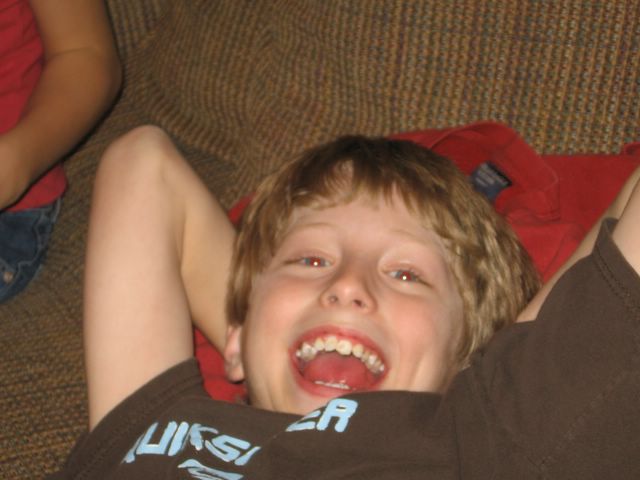Small Life Style Changes
Jenny says:
A. Wearing the monitor
The monitor is bigger than an insulin pump, so I think it takes a little getting used to wearing for a 60 pound kid. But on the 5th day of keeping track of the Guardian monitor, I think he is finally used to it. For the first few days, I was trying to keep it on something nearby like a chair or table so that I didn't have to bug him if I wanted to see the numbers. But he never stayed in one place for very long and he often didn't remember to bring it with him, so it would alarm frequently and then I would have to go and find him. (Once the monitor can't find you, it alarms until you find it.) The monitor and the transmitter also have had some trouble communicating at night if Tommy rolls over a certain way or is bundled in lots of covers. So, we have decided that when Tommy is wearing the Guardian, it is either in his pocket or clipped to the waist of his pants. When he is sleeping, I have found that when I lay it on the bed next to him rather than on his night stand it still can find him, and I can take a look at the numbers or turn off an alarm without waking him up. (The alarms wake me up before they wake Tommy up. Heavy sleeper. Supposedly, if we were not to wake up and clear the alarm, it just keeps getting louder and louder.)
We look forward to the Minimed Pump 522 that will eliminate wearing this bulky monitor.
B. Calibrating the Guardian in Steady Waters
From Wil's blog (www.lifeafterdx.blogspot.com) and the Guardian literature it is explained that to get the numbers on the Guardian monitor to be as acurate as possible, it is important to calibrate the Guardian with numbers from a finger stick that was taken in calm times. By calm times or "steady waters" they mean that a number is not moving up or down very rapidly and that the number is neither very low or very high. (Even meters aren't that accurate when at those high levels.) We sometimes have trouble finding numbers that aren't quickly moving up or down. We learned a few days after wearing this Guardian that you need to enter a steady number at least 15 minutes before eating or giving insulin. You have to do that at least once every 12 hours. It has taken an extra thought to remember to calibrate.
C. Finger sticking
Ideally Tommy should do a finger stick test 15 minutes before he eats so that he can use it for a calibration check and to help him figure his meal bolus amount. This seems to take a little more thought than what we were doing. He was usually testing after the first few bites of his food.
Tommy has currently reduced his finger sticks by 2 or 3 per day. He is still poking before meals and at low/high alarms. I believe that as time goes on, we will be getting less low/high alarms and sometimes using the Guardian # to bolus for a meal; therefore, reducing finger pokes even more. The numbers seem relatively trustworthy so far.
D. Double site changes
We have so far decided to change his pump and the Guardian on different days just because it still seems so complicated. The Guardian literature says that it would be best to put it on in the morning. Tommy has only put two sensors in. I am hoping that it will soon become uneventful like when he puts in his pump site. Maybe then we will do them at the same time.
E. Entering Events like insulin and food
On the monitor, there is an option to enter an event like insulin, food, exercise, etc. This is very nice because when you look at the graphs in the Solutions software it helps to see when these things happened and what the sugars looked like hours afterwards. Since Tommy hasn't really seen the graphs yet, he is not very motivated to take the extra time to enter these events into his Guardian. (He is usually already entering data into his pump at these times.) So the data when at school, I have to get from the Carelink software from his pump. (This problem will also go away with the 522 pump because the finger stick checks will go straight to the pump without Tommy even pressing a button. Also, the 522 people will be using only Carelink software which will combine information from the pump, the sensor and the meter.)
Subscribe to:
Post Comments (Atom)

No comments:
Post a Comment